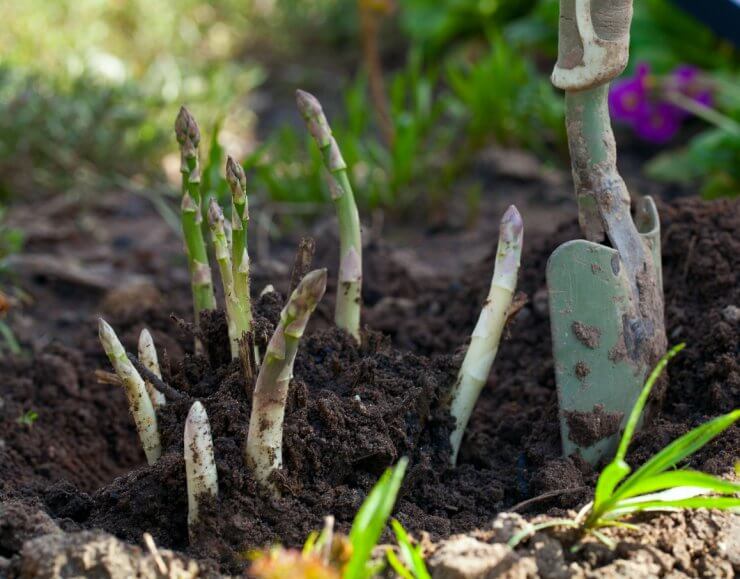
Asparagus growing in open land
Asparagus is easy to plant and grow, but because this vegetable is a perennial, it has some special requirements for planting. Whether you grow asparagus in raised beds or open land, your crop will keep producing for decades, so be sure to give your asparagus garden plenty of space as they will spread and create new shoots each year. Asparagus plants also grow quite tall—upwards of 6 feet; expert asparagus growers suggest positioning your patch on the north or east side of your garden to keep them from shading the other plants or create an asparagus bed off by itself. Asparagus needs plenty of sun and moist soil with a pH range of 6.5 to 7.0, so avoid planting near a crop that prefers dry or acidic soil.
If you have a large outside plot of land with the right soil and the right conditions for watering and draining, you might have the ideal situation for planting your asparagus directly in the ground. If, however, your soil has too much clay or poor drainage, you might want to consider planting in raised beds or in containers.
Growing in Raised Beds

Asparagus in a raised bed
Raised beds are a great option for growing asparagus. Creating raised beds for your asparagus garden can be a lot of work the first time you set up your beds, but having raised beds allows you more control over your growing environment. You’ll discover that watering, irrigation, weeding, and even harvesting are much easier, with items closer to your reach and contained in a space that is more manageable than growing in open land.
To create nicely contained raised beds for your asparagus, enclose your raised beds with wooden sides 10 to 12 inches deep—this will give the plants’ roots room for spreading. Asparagus crowns should be spaced 18 inches apart, so plan the length of your raised bed accordingly.
A raised bed garden is less likely to contain the seeds of weeds that are often found in garden soil. This is critical with young asparagus plants—especially if you’re growing from seed: asparagus shoots cannot compete with weeds or grass at all. Preparing raised beds for your asparagus crop not only minimizes the incidence of weeds overall, weeding itself is much easier with raised beds, because you don’t have to get down so far on the ground to remove weeds.
Raised Bed Planting Tip: Be sure to amend your soil with compost at least once a year. Otherwise, your soil can become less productive for your plants.
Growing Asparagus in Containers or Pots

Garden pots prepped for asparagus and other plants
If you don’t have the space for growing in open land or in raised beds—let’s say you live in an apartment with no land of your own for a garden, for example—you can still grow asparagus in containers or pots on your balcony, porch, patio, or deck. You won’t get as many harvesting years out of the plants this way—two to four years compared to 20 or more in beds—but for the true asparagus lover, having fresh-picked asparagus is worth it.
One great advantage to container gardening is the ability to move plants around more easily to maximize their exposure to the sun. Asparagus need six to eight hours of sun a day to fully fruit.
Tip: If you have trouble moving pots around, because they’re too heavy or too bulky, try putting your pots on slightly raised rolling casters so you can more easily move them around your space.
In the spring, select your plants and pots. As with planting asparagus in the ground or beds, make sure you put them in pots that have room for the roots—at least 18 inches deep and 12 inches across. Like any plant, asparagus needs good drainage, so select a container with one or more drainage holes or drill holes in it when you’re about to plant. Fill the bottom with 2 inches of gravel and the rest with a mix of potting soil and compost. Plant the crown 4 to 6 inches deep, water well, and place the container outside in a location that receives at least eight hours of sun a day. Shoots should appear within a week. Apply mulch around the shoots to keep away weeds and to retain moisture.
Though weeding is much easier with containers, you have to be more vigilant with asparagus as the weeds will compete with the plant’s nutrition and growth. You also have to keep close tabs on watering and irrigation as plants can dry out much faster in pots than when they’re in the ground. Plus, containers can lose important soil nutrients throughout the season, so you might need additional fertilizer.
It will take two to three years for your asparagus plants to become established and yield a harvest. After that, you’ll have two to four years to enjoy your container-grown asparagus. You can leave these hardy perennials outdoors during the fall and winter seasons. Dormant plants will resume growing in the spring. So long as your plants are healthy and not affected by disease, you can keep them in the same soil year after year, topping off if needed.
How do you grow your asparagus—in open land, in raised beds, or in containers? Why do you prefer your method? Please tell us your tips and tricks for creating a bountiful asparagus garden.


 Previous
Previous


I planted my asparagus 2 yrs ago. I have a few asparagus but tons of green frons growing abt 4 ft. tall. Do I leave the frons or cut them?
Mary Ann
You should leave the frons until they die back in the fall. They are what feeds the roots. You will proably harvest some next year.
Gary